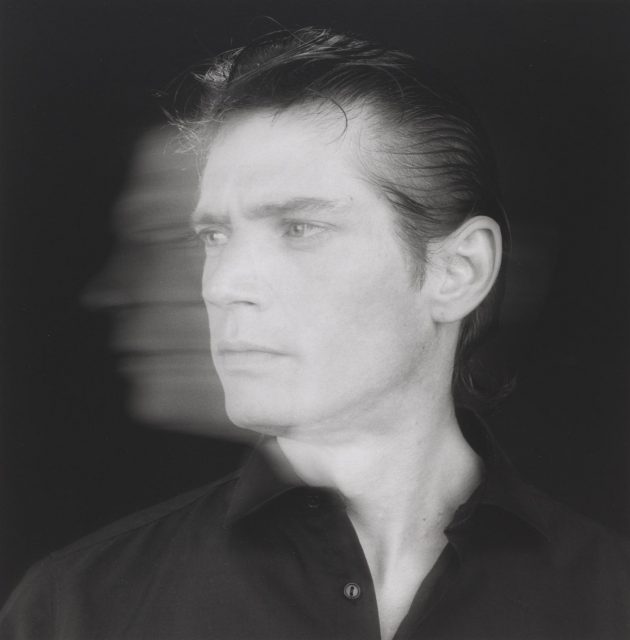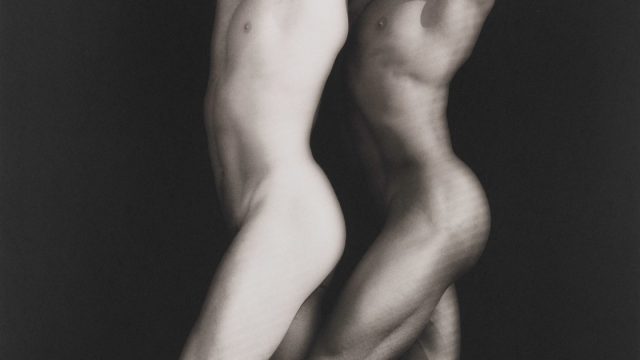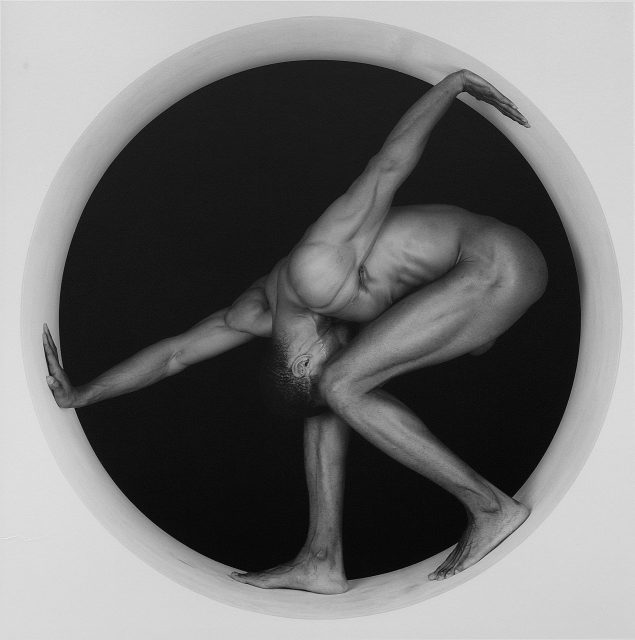
Robert Mapplethorpe, Self Portrait, gelatin silver print, 1985 (Solomon R. Guggenheim Museum, New York; gift, the Robert Mapplethorpe Foundation, 1996)
Solomon R. Guggenheim Museum
1071 Fifth Ave. at 89th St.
Through July 10, $18-$25 (pay-what-you-wish Saturday 5:00-7:00)
Part 2 runs July 24 – January 5
212-423-3587
www.guggenheim.org
There’s only one week left to see the first phase of the Guggenheim’s yearlong, two-part exhibition “Implicit Tensions: Mapplethorpe Now,” a concise survey in conjunction with the thirtieth anniversary of the death of visual artist Robert Mapplethorpe in 1989 at the age of forty-two. Mapplethorpe’s reputation has been growing since the January 2010 publication of Patti Smith’s award-winning book Just Kids, which details the punk rocker’s relationship with Mapplethorpe, from lovers to best friends and artistic collaborators in the late 1960s and 1970s. More recently, there was the 2016 documentary Mapplethorpe: Look at the Pictures and the 2018 biopic Mapplethorpe as well as Bryce Dessner’s multimedia Triptych (Eyes of One on Another), which used music and images to focus on several of the controversies surrounding Mapplethorpe’s work, from obscenity charges to questions about racism and his photos of black bodies. “Implicit Tensions” circumvents all of that and concentrates on his immense skill in composition and his immeasurable artistic vision in his photographs of flowers, sadomasochism, male and female nudes, and, most notably, himself, although he’s no mere narcissistic selfie taker.

Robert Mapplethorpe, Ken and Tyler, platinum-palladium print, 1985 (Solomon R. Guggenheim Museum, New York; gift, the Robert Mapplethorpe Foundation, 1996)
The Guggenheim show consists of more than fifty photographs and unique objects from the museum’s collection, gifts from the Robert Mapplethorpe Foundation between 1993 and 1998 that led to the Guggenheim developing and expanding its photography collection and forming its Photography Council. The wholly satisfying exhibit is somewhat of a greatest hits display, with iconic photos as well as pictures of such well-known figures as Arnold Schwarzenegger, Louise Bourgeois, Andy Warhol, Cindy Sherman, Laurie Anderson, Candy Darling, Philip Glass with Robert Wilson, David Hockney with Henry Gelzahler, and Smith. Mapplethorpe treated all his subjects equally, whether a celebrity, a lover, a flower, an S&M scene, or himself. “My interest was to open people’s eyes, get them to realize anything can be acceptable,” he said in an interview. “It’s not what it is, it’s the way it’s photographed.”
Using Polaroid and Hasselblad cameras, among others, Mapplethorpe captured a bold intimacy in his work, which, in 2019, seems more revolutionary than shocking, although some photos are still daring and outrageous. Early on, he created such collages as Black Bag, Green Bag, and Red Bag, made of clippings from gay porn magazines arranged behind a mesh screen, placing homosexuality tantalizingly out of reach (and seemingly imprisoned). In Dominick and Elliot, a bound and naked Dominick is upside down, as if in a reverse crucifixion pose, next to the shirtless Elliot, who has a cigarette in one hand, Elliot’s testicles in the other. In Ken Moody and Robert Sherman, Moody’s and Sherman’s heads are seen sideways as they look seriously off into the distance, the former’s blackness and the latter’s whiteness almost blending together. It’s a visual companion piece to Ken and Tyler, with Moody’s and Tyler’s nude bodies — their heads are out of the frame — right behind each other, facing the same direction as Ken’s and Robert’s heads.

Robert Mapplethorpe, Thomas, gelatin silver print, 1987 (Solomon R. Guggenheim Museum, New York; gift, the Robert Mapplethorpe Foundation, 1993)
This theme of dichotomy is central to the bisexual Mapplethorpe’s oeuvre and is fully evident at the Guggenheim. Two of the most telling photos are a pair of 1977 works titled Pictures/Self Portrait, which were invitations to a gallery show. In both, Mapplethorpe’s hand is writing the word “Pictures”; in one, the hand is shown in a conventional man’s shirt and watch, while in the other the hand wears a black leather glove and a brash metal bracelet, equalizing and contrasting so-called normal and S&M costuming. In one gelatin silver print of bodybuilder Lisa Lyon, she is dressed in black, as if at a funeral, while in another she is nude except for a white sheet over her face that falls like the train of a wedding dress to the floor.
The implicit tension is also on display in Mapplethorpe’s numerous self-portraits, which range from the angelic to the demonic; he has evil horns in one and holds a skull-topped cane in another, while in a third he is elegant in a lush fur and wearing lipstick. In two 1980 self-portraits, he is shirtless and androgynous in one, smoking a cigarette and wearing a leather jacket in the other, comparing sensitivity with toughness as he addresses gender identity and societal ideas of maleness. And then there’s American Flag, a photograph of a ratty, torn flag that speaks volumes. Mapplethorpe had a very personal way of depicting both the private and the public, and thirty years after his death from HIV/AIDS complications, his pictures still get under your skin, the man behind the camera — and in front of it — as elusive as ever, and just as beautiful and beguiling. The second phase of “Implicit Tensions” opens July 24 and will examine Mapplethorpe’s legacy and influence, combining his works with those of Rotimi Fani-Kayode, Lyle Ashton Harris, Glenn Ligon, Zanele Muholi, Catherine Opie, and Paul Mpagi Sepuya.